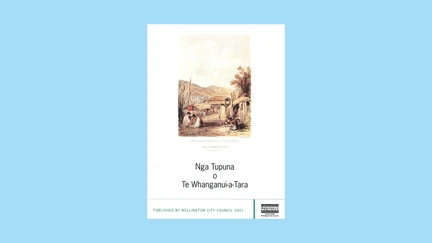Ngā Tupuna o Te Whanganui-a-Tara, Hei Tīmata - Nga Tupuna Introduction
Read an online version of the introduction to Volume 1 of 'Nga Tupuna o Te Whanganui-a-Tara', published in 2001.

Published Text
"Introduction". In Nga tupuna o Te Whanganui-a-Tara, volume 1, written and researched by Sandra Clarke for Wellington City Libraries, with assistance from Ann Reweti and Lotofoa Fiu. (2001)
A few years ago Emeritus Professor Alan Ward wrote a book which included a list of the signatories of the "Deeds of Release" for the Port Nicholson area. These deeds were signed on the 26th February 1844 at Te Aro, Kumutoto, Pipitea and Tiakiwai, on the 15th March at Waiwhetu, on the 26th March at Pakuao and Kaiwharawhara, at the 2 villages of Waiariki and Te Ikamaru on the 29th March and finally at Oterongo and Ohaua on the 30th March. Professor Ward suggests that little is known about the extent of the authority of these signatories to represent their hapu.
The authors of this document are practicing librarians who are only too keenly aware how difficult it is to find information about the Maori Leaders of Port Nicholson or Wanganui-o-Tara in the 1840s. We hope that the short biographies that follow, together with portraits where they are available, will start to fill the gap.
Some of the people included have already been well covered by the Dictionary of NZ Biography, 1990-2000. Their condensed biographies have been included in this volume so that a balanced picture of the Maori leaders in the area during the settlement period can be presented as far as is possible.
We hope we have given a general overview of the hapu and iwi who had quite recently migrated to Whanganui-a-Tara from the Taranaki Rohe in the 1820 to 1840 period.
Book one focused more on Te Aro and Pipitea Pa, with Waiwhetu Marae, while book two takes in Ngauranga, Kaiwharawhara, and around the southwest coast including Ohariu to Makara.
I Te Reo Māori -
I ngā tau ki muri i tuhia e Alan Ward Whakahōnore Ahorangi, tētahi pukapuka e mau ana i ngā rārangi ingoa o ngā kaihaina o te 'Whakaaetanga Tuku Whenua' i te rohe o Pōneke. I hainatia ēnei whakaaetanga i te rā 26 o Hui-tanguru 1844 i Te Aro, i Kumutoto, i Pipitea me Tiakiwai. I te rā 15 Poutū-te-Rangi i hainatia i Waiwhetu, i Pakuao me Kaiwharawhara. I ngā kāinga e rua o Waiariki me Te Ikamaru i hainatia i te rā 29 o Poutū-te-Rangi, ā, ko te mutunga o ēnei hainatanga i mahia ki Oterongo me ōhaua i te rā 30 o Poutū-te-Rangi. E ai ki a Ahorangi Ward, kāore i te tino mōhiotia mehemea i ngā kaihaina te mana ake o o rātou hapu, hei māngai mō rātou
Kei roto i ngā pukapuka 'Ngā Taumata Rau 1990-2000' ētahi kōrero whānui mō ēnei tāngata. Kua whakaurua te whakarāpototanga haurongo o ēnei ki roto i tēnei, kia pai ai te whakarato i te āhua rite o ngā rangatira Māori i te rohe, i te wā o te taenga mai o te Pākeha.
Ko te tūmanako he tirohanga whānui tēnei ki ngā hapu me ngā iwi i heke ki Te Whanganui-a-Tara mai te rohe o Taranaki i ngā tau 1820 ki ngā wā o 1840. Ko te nuinga o rātou i ahu mai i ngā Iwi e toru: Ko Te āti Awa, he iwi e noho ana i te tokerau o Taranaki; Ko Taranaki, i ahu mai i te ākau ki te tonga o New Plymouth: Ko Ngāti Ruanui o Taranaki ki te Tonga (te rohe o Hāwera). I kīia i Te Kōti Whenua Māori, ko te hapu o Whanganui i whai mai i a Ngāti Tama, i noho ki Ohāriu, i muri mai o te taenga mai o te kaipuke Tory i te tau 1839. I tōna wā neke atu i te 90 ngā hapu/iwi e kōrerohia ana mō te rohe o Taranaki.